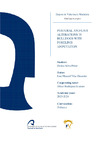Identificador persistente para citar o vincular este elemento:
https://accedacris.ulpgc.es/jspui/handle/10553/131461
| Campo DC | Valor | idioma |
|---|---|---|
| dc.contributor.advisor | Vilar Guereño, José Manuel | - |
| dc.contributor.advisor | Rodríguez Lozano, David Oliverio | - |
| dc.contributor.author | Silva Pérez, Denise | - |
| dc.date.accessioned | 2024-06-30T20:03:56Z | - |
| dc.date.available | 2024-06-30T20:03:56Z | - |
| dc.date.issued | 2024 | en_US |
| dc.identifier.other | Gestión académica | |
| dc.identifier.uri | https://accedacris.ulpgc.es/handle/10553/131461 | - |
| dc.description.abstract | The present project corresponds to the study carried out on animals of the French bulldog canine species, which underwent amputation of a forelimb, and animals of the same species and breed with the presence of all four limbs. The objective is to obtain the results of the biomechanical adaptations generated in an animal whose gait is tripedal compared to an animal whose gait is performed on all four limbs. This is of great interest since a high compensatory effort is generated as it is forelimb, so it is important to know the changes in the redistribution of the animal´s weight both in static and dynamic. Throughout the report, a theoretical framework is presented, where a series of concepts are presented prior to the reading of the study itself in order to facilitate its comprehension, taking into account basic terms of kinetic analysis as well as the description of the tools used. The proyect was performed on 5 amputee dogs and 5 sound animals. For this purpose, various parameters were measured both statically and dynamically by simultaneous use of force and pressure platforms. The results were compared statistically with the help of Student´s t test. It was observed the parameters derived force and propulsive force, as well as their respective impulses, were significantly higher in the contralateral limb of the limbless group of animals. In addition, an increase in peak pressure, mean pressure and paw area was observed in these animals. On the other hand, postural examination showed that amputee dogs achieved the same stability as sound dogs, implying an increase in strength in the contralateral limb that could lead to a potential increase in the early onset of injuries in various musculoskeletal units due to overuse. | en_US |
| dc.language | eng | en_US |
| dc.subject | 310910 Cirugía | en_US |
| dc.subject.other | vertical force | en_US |
| dc.subject.other | pressure | en_US |
| dc.subject.other | amputation | en_US |
| dc.subject.other | equilibrium | en_US |
| dc.title | Postural and gait alterations in bulldogs with forelimb amputation | en_US |
| dc.type | info:eu-repo/semantics/bachelorThesis | en_US |
| dc.type | BachelorThesis | en_US |
| dc.contributor.departamento | Departamento de Patología Animal, Producción Animal, Bromatología y Tecnología de Los Alimentos | en_US |
| dc.contributor.facultad | Facultad de Veterinaria | en_US |
| dc.investigacion | Ciencias de la Salud | en_US |
| dc.type2 | Trabajo final de grado | en_US |
| dc.utils.revision | Sí | en_US |
| dc.identifier.matricula | TFT-21457 | |
| dc.identifier.ulpgc | Sí | en_US |
| dc.contributor.buulpgc | BU-VET | en_US |
| dc.contributor.titulacion | Grado en Veterinaria | |
| item.grantfulltext | open | - |
| item.fulltext | Con texto completo | - |
| crisitem.advisor.dept | GIR IUIBS: Medicina Veterinaria e Investigación Terapéutica | - |
| crisitem.advisor.dept | IU de Investigaciones Biomédicas y Sanitarias | - |
| crisitem.advisor.dept | Departamento de Patología Animal, Producción Animal, Bromatología y Tecnología de Los Alimentos | - |
| crisitem.advisor.dept | GIR IUIBS: Trypanosomosis, Resistencia a Antibióticos, Virología y Medicina Animal | - |
| crisitem.advisor.dept | IU de Investigaciones Biomédicas y Sanitarias | - |
| crisitem.advisor.dept | Departamento de Patología Animal, Producción Animal, Bromatología y Tecnología de Los Alimentos | - |
| Colección: | Trabajo final de grado | |
Los elementos en ULPGC accedaCRIS están protegidos por derechos de autor con todos los derechos reservados, a menos que se indique lo contrario.
